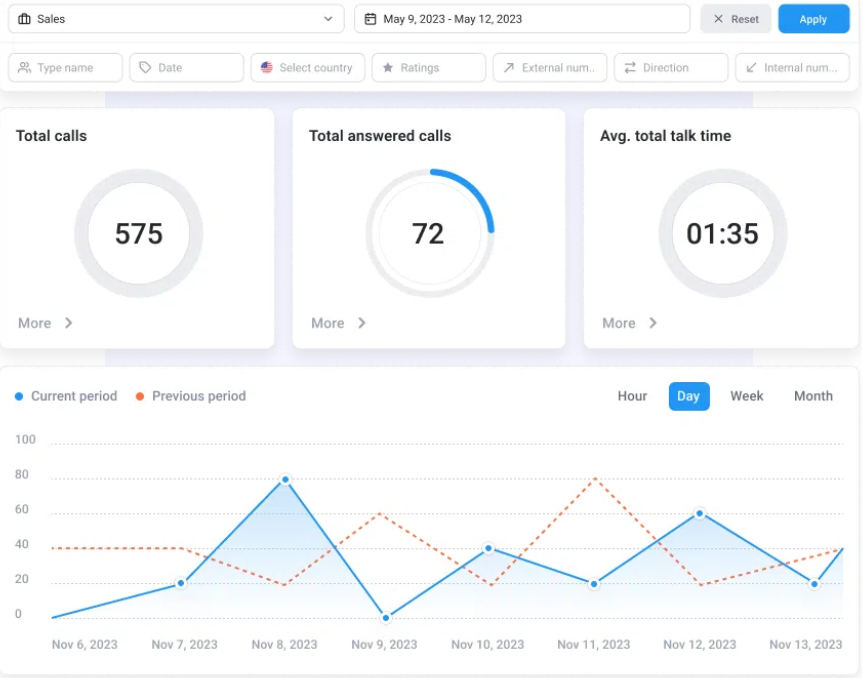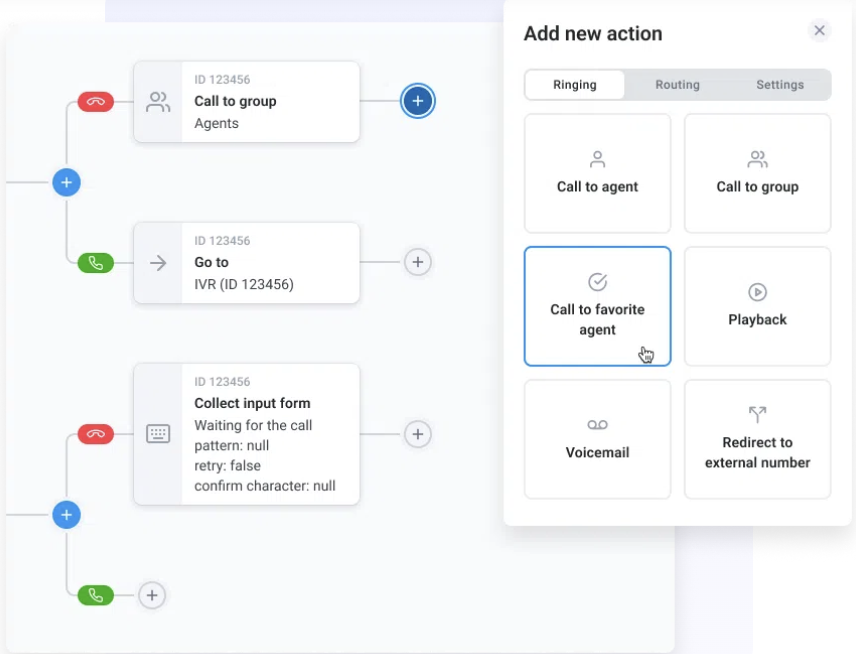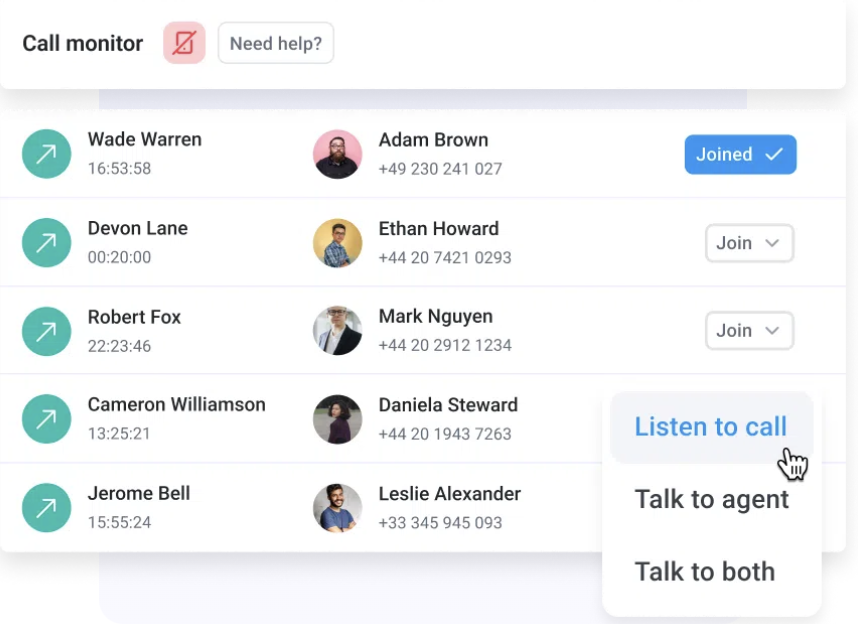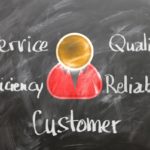8 Tips for Effectively Managing Call Center Operations

94% of customers say a positive service experience makes them more likely to return, yet only 13% feel their issues are resolved with ease.*
To stand out, resolving customer issues quickly and effortlessly is key. However, this is easier said than done.
As a call center operations manager, you face daily challenges like managing workflows, boosting agent performance, and reducing call wait times—all while striving to keep customers happy.
To help, we’ve compiled top tips for effective call center management. Discover how to streamline processes, tackle challenges, and unlock the full potential of your team and business.
Key Takeaways:
- KPIs can show you where your team is succeeding and where your agents may be struggling so you can take action to improve.
- Well-trained agents are more confident, handle customer queries more effectively, and eliminate unnecessary errors for a better customer experience.
- Software like CloudTalk integrates with your CRM, giving agents instant access to customer data for faster, more personalized support.
Let CloudTalk shift your call center into high gear
What Factors Impact Call Center Operations?
While they used to be considered different terms, “call center” and “contact center” are now used interchangeably. Customers connect with companies through email, chat, messaging apps, and social media. The term “contact center” reflects this shift to omnichannel service.
The success of your call center is no longer limited to the effective handling of inbound calls. You need to prioritize an omnichannel approach to customer service that delivers a seamless customer experience regardless of the medium.
The following are key factors that affect customer experience and your call center operations as a whole:
- Staffing levels: Having enough agents on staff leads to shorter wait times and better service. While cutting back on staff to save money may be tempting, understaffing leads to delays and frustrated customers.
- Technology: Modern tools like call center software, CRM systems, and AI-driven analytics help agents provide faster, more personalized support.
- Training: Well-trained agents are more confident, handle queries more effectively, and eliminate unnecessary errors for a better customer experience.
- Customer expectations: Customers expect nearly instant communication across multiple channels. Meeting these expectations is now key to staying competitive.
- External variables: Factors like seasonal spikes or industry trends can strain resources, impacting response times and service quality, so be sure to account for this!
Best Practices for Effective Call Center Management
Managing the day-to-day operations of your call center business can be taxing. When you’re focused on keeping the business going, it’s hard to avoid getting bogged down by urgent tasks or details. However, it’s also essential to create long-term plans to keep your business growing.
We’ve highlighted some best practices to help you stay focused on the big picture and achieve long-term success.
1. Establish Clear Objectives and KPIs
It’s pretty hard to run a business based on feelings alone. Call center Key Performance Indicators (or KPIs for short) are metrics that help you gauge the performance of your business.
These numbers give you an objective view, letting you know your team is on track to achieve your business objectives. Tracking KPIs can also help you identify any underlying issues or blockers holding your business back from reaching its full potential.
Here’s a quick summary of some of the key KPIs for call centers:
- Customer Satisfaction (CSAT): Measures how happy customers are with your service. Use surveys to pinpoint issues and improve satisfaction.
- Net Promoter Score (NPS): Indicates how likely customers are to recommend your company. A high NPS shows loyalty and the potential for repeat business.
- Blocked Calls: Tracks incoming calls that can’t get through due to busy signals. High numbers may indicate staffing or technical issues.
- Call Arrival Rate: Monitors the volume of calls over time, helping you schedule agents during peak times and adjust for fluctuating demand.
- Average Wait Time (AWT): Measures the time customers wait in the queue. Shorter wait times lead to higher satisfaction.
- Average Time to Abandon (ATA): Tracks the percentage of customers who hang up before speaking to an agent. High abandonment rates often signal understaffing or long wait times.
- Average Handle Time (AHT): Measures how long it takes to resolve a call. Be cautious not to rush agents, as it can impact service quality.
- Average After Call Work Time (ACW): Tracks the time agents spend on post-call tasks. High ACW may indicate a need for better training or process improvements.
- First Call Resolution (FCR): Measures how often customer issues are resolved on the first call. High FCR boosts satisfaction and reduces churn.
- Agent Turnover Rate: Tracks how often agents leave. High turnover can affect team morale and service quality, so addressing causes is crucial.
2. Optimize Staffing and Scheduling
When is your call center the busiest? Depending on the nature of your business, this answer may vary. By identifying peak periods, you can adjust schedules to make sure you have enough available agents without paying for staff you don’t need.
Tools like workforce management software can help with forecasting and shift planning, offering insights into call volume trends and allowing you to allocate resources accordingly. These tools can predict peak hours, so you can schedule agents when they’re needed most and avoid the pitfalls of understaffing or overstaffing.
Having versatile staff is also key. Cross-training agents to handle different types of calls makes it easier for your team members to adapt to varying demand and provide consistent service across all channels. This handy online calculator helps to estimate the number of call center agents you need depending on a variety of factors as outlined below:
Calculator Input
Description
Example Input
Number of calls per hour
The number of calls you receive every hour
e.g., 120
Average handling time
Average call duration, including wrap-up time in seconds
e.g., 300 (5 minutes)
Percentage of calls to be handled
The percentage of customers you would like served during your maximum wait time
e.g., 90%
Waiting time
The longest a caller can wait before reaching an agent
e.g., 60 seconds
While cutting corners on staffing may seem like a quick fix to save money, it often leads to poor service quality and higher burnout rates.
Understaffed teams struggle with overwhelming call volumes, leading to frustrated customers and overworked agents. This impacts customer satisfaction and increases turnover, making it a costly mistake in the long run.
Pro tip:
Address customer concerns before they arise. Discover how Analytics can help you anticipate customer needs and refine your communication strategy.

3. Leverage Call Center Software and Automation
Tackling call center challenges is easier with the right tools. Call center platforms like CloudTalk integrate with your CRM, giving agents instant access to customer data for faster, more personalized support.
Meanwhile, self-service features like AI chatbots and Interactive Voice Response (IVR) give your agents a break and streamline operations.
By adopting these technologies, you can overcome common obstacles, boost call center performance, and deliver a better experience for both your call center team and your customers.
Here are some of the features of call center technology and how they facilitate effective call management:
- Streamline tasks with automation: Workflow Automation takes care of routine tasks like follow-up reminders, ticket creation, and call transcription. Custom workflows free up agents to focus on customer calls and establish a high level of service.
- Customize your call flow: With tools like Call Flow Designer (CFD), you can customize every step of the customer journey. Take advantage of 20+ pre-built routing options, create custom call flows via simple to use drag-and-drop, and scale them across your entire operations.

- Simplify routing with Interactive Voice Response (IVR): IVR uses a pre-recorded menu with multiple options to determine each caller’s concerns and connect them to the right team. This gives agents an idea of why a client is calling, priming them to deliver more targeted service, improving satisfaction and reducing call durations by as much as 40%.
- Optimize call routing with Call Queueing: Assign skill tags to agents and route calls to the right person based on their expertise. This connects customers with the person who can best help them, increasing the likelihood of first-call resolution (FCR) and minimizing transfers.
- Boost productivity with a Power Dialer: Reach more prospects faster. Power Dialer automates workflows and dials for you. Agents go from one call to the next, keeping them in the zone, and alleviating their workload by automatically logging important information in your CRM.
4. Invest in Agent Training and Development
Your call center agents are the frontline workers representing your business. They have a direct impact on how customers view your brand. Their interactions—whether positive or negative—shape clients’ overall impression of your company.
Training shouldn’t be limited to onboarding. While agents can gain valuable experience on the job, investing in continuous coaching and training keeps agents up-to-date on any changes in the business and helps them grow and develop their knowledge base and hone their skills over time.
Training doesn’t have to disrupt daily operations. With tools like CloudTalk, you can incorporate training into your agents’ daily routines. Features like Call Monitoring allow you to listen in on calls and provide real-time assistance when needed, while Agent Reporting lets you track KPIs and identify areas for improvement. This data-driven approach allows you to tailor your training based on your agents’ actual performance, addressing skill gaps and boosting their effectiveness.

5. Equip Call Center Agents with the Right Customer Information
Providing agents with comprehensive customer data, like purchase history, preferences, and past interactions, helps them deliver more personalized and efficient service.
Imagine a customer calling to ask about a delayed order. With access to their purchase history, the agent can instantly identify the order, confirm the shipping details, and provide an updated delivery timeline. The agent may also note that the customer has purchased similar products in the past and take it upon themselves to offer a complementary item or a discount as a gesture of goodwill.
Access to this information allows agents to address customer needs quickly, resolve issues more effectively, and enhance the overall customer experience. This not only speeds up resolutions but also boosts customer satisfaction by ensuring each interaction is tailored to the individual.
6. Foster Strong Communication
Open communication between agents and managers is crucial for tackling challenges on the go and maintaining seamless operations and consistent customer service. Regular check-ins and feedback loops help identify issues early, so you can start problem-solving before they escalate.
Communication platforms like CloudTalk keep both remote and in-house teams connected. Features like Group Reporting, Agent Status, and Wallboards enable quick real-time updates and collaboration.
Establishing standardized communication procedures for different call scenarios ensures consistency and efficiency across all interactions, helping agents navigate customer inquiries with confidence and clarity.
7. Prioritize Customer Experience
When a customer calls your business, they’re looking for swift, effective solutions—not repeat conversations. Ensuring their issues are resolved during the first interaction builds trust and satisfaction, making each call a step toward loyalty.
First Call Resolution (FCR) tracks how many customer issues are resolved during the first interaction. This metric reflects your reps’ ability to address customer needs quickly and effectively.
There are many benefits of FCR, including:
- Reduced wait times: FCR reduces repeat requests and increases upselling opportunities, making your contact center more cost-effective. Reps can help more customers, reducing hold times and offering a better quality of service without the need for escalation.
- Increased customer loyalty: Customers who experience quick and efficient service resolutions are more likely to recommend your service to others, boosting brand reputation, reducing churn, and increasing customer loyalty and retention. Retaining existing customers is far more cost-effective than acquiring new ones.
- Improved agent experience: FCR data helps identify top performers and areas for improvement, reducing burnout and turnover while giving you insight to improve agent training.
Encourage Feedback to Enhance Customer Experience
A feedback loop is a process where information or feedback from a customer is collected, analyzed, and used to improve service or operations.
Implementing a feedback loop in your call center might look something like this:
A customer contacts your call center and has a positive experience with a representative who quickly resolves their issue. After the call, the customer leaves positive feedback via a survey or rating system.
The feedback loop: Thank the customer for their positive feedback and inform them that their comments will be shared with the specific agent involved (if applicable).
Steps to take:
- Assess if this high level of service is consistent across all agents or if this particular agent excels in certain areas.
- Acknowledge the agent’s performance by directly thanking them for their excellent service.
- Provide training: Use the agent’s performance as a benchmark for other agents, organizing training sessions or workshops to share best practices.
- Reward excellence: Implement an internal rewards system to recognize agents who consistently receive positive feedback and incentivize employees.
- Promote your team: Highlight standout agents and their positive customer interactions on social media or through case studies, showcasing your call center’s commitment to excellent service.
8. Implement Performance Analytics and Reporting
Tracking KPIs is important, but don’t overlook the value of qualitative customer feedback loops—it gives you a deeper look into how your agents are really doing and how customers feel.
By combining both types of data, you get a more complete picture of what’s working and where things could improve. Performance analytics help you spot trends, identify roadblocks, and figure out where agents might need extra support.
Regular reports to senior management keep everyone in the loop and ensure decisions are based on the latest insights, helping you make smart adjustments that boost agent performance and strengthen your customer relationships.
Cut Call Handling Time by 40%* With the Right Tools
Managing the ins and outs of call center operations is a tall order. Doing it successfully requires getting clear on key call center metrics and effectively translating goals into actionable steps for agents.
By enhancing core performance indicators like customer satisfaction rate, average wait times, and first call resolution, businesses can gain significant advantages. For instance, boosting customer satisfaction, lowering operational costs, and improving agent effectiveness along with employee engagement.
Integrating software like CloudTalk and investing in ongoing training is essential to achieving these performance goals. By monitoring agent calls and ensuring seamless integrations, you can provide a top-notch omnichannel experience and keep customer satisfaction at the heart of your business.
Supercharge your call center operations
Sources
- SalesForce. Contact Centers vs. Call Centers.
- CloudTalk. Analytics Feature.
FAQs about Call Center Operations
How does a call center work?
A call center consists of a team of agents who field inbound and outbound calls to assist with inquiries, customer support, or sales.
What is call center quality management?
Quality management, or quality assurance, involves monitoring calls, assessing performance, and implementing training to improve customer interactions.
How much does a call center operations manager earn?
A call center operations manager earns an average salary of $60,000 to $90,000 annually, depending on experience, location, and company size.
What’s an example of a call center operations manager job description?
A call center operations manager oversees daily operations, manages teams, ensures customer service quality, and optimizes processes to meet business goals.























